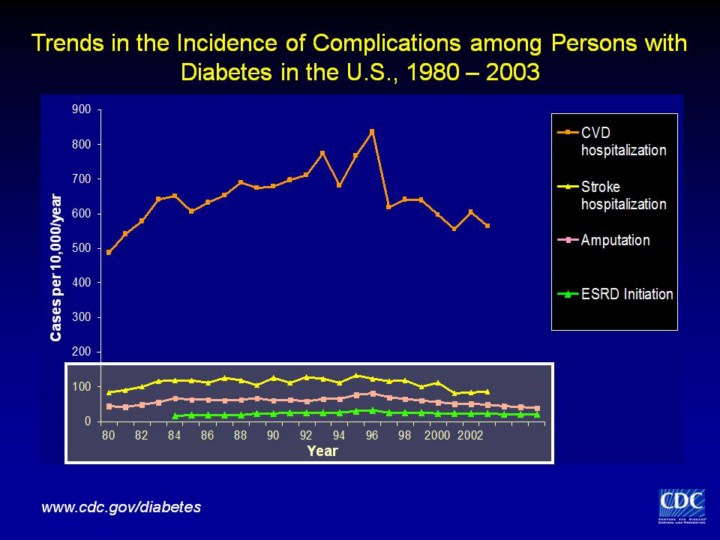| front |1 |2 |3 |4 |5 |6 |7 |8 |9 |10 |11 |12 |13 |14 |15 |16 |17 |18 |19 |20 |21 |22 |23 |24 | 25|26 |27 |28 |29 |30 |31 |32 |33 |34 |35 |36 |37 |38 |39 |40 |41 |42 |43 |44 |45 |46 |47 |48 |49 |50 |51 |52 |53 |54 |review |
 |
The U.S. Renal Data System (USRDS) is a surveillance system for end-stage renal disease (ESRD) funded by the National Institute of Diabetes and Digestive and Kidney Diseases of the National Institutes of Health. USRDS collects, analyzes, and distributes information from clinical and claims data reports to the Centers for Medicare and Medicaid Services (CMS) regarding patients being treated for ESRD. CMS reimburses most of the total cost of ESRD treatment in the United States, supplies most of the data used by USRDS, and provides expertise on data management. USRDS is estimated to include more than 93 percent of the ESRD population in the United States.We defined ESRD-DM incidence as cases initiating treatment for ESRD (dialysis or kidney transplantation) and having diabetes listed as the primary cause of renal failure. Rates were calculated using two population estimates: 1) the resident U.S. population from the Census, and 2) the number of U.S. residents with diabetes obtained from the weighted sample of the civilian noninstitutionalized population in the National Health Interview Survey (NHIS). Three-year moving averages were used to improve the precision of the estimated population with diabetes, and incidence was age-adjusted on the basis of the 2000 U.S. standard population. For the series of maps, ESRD-DM incidence was also calculated using two population estimates: 1) state-specific estimates of the U.S. resident population during 1985 and 2002 from the Census, and 2) state-specific estimates of the U.S. population with diabetes during 1994 and 2002 from CDC's Behavioral Risk Factor Surveillance System (BRFSS). BRFSS is an ongoing, state-based telephone survey of the noninstitutionalized population aged 18 years or older that provides state-specific information on behavioral risk factors and preventive health practices. Respondents were considered to have diabetes if they responded "yes" to the question, "Has a doctor ever told you that you have diabetes?" Women who indicated that they only had diabetes during pregnancy were not considered to have diabetes. Except for 1994 and 2002 (2-year averages), 3-year averages were used to improve the precision of the state-specific estimates of the population with diabetes, and at least two years of data were required to obtain the estimate. Incidence was age-adjusted on the basis of the 2000 U.S. standard population using two age groups (18-64 years and 65 years or older). Limitations The USRDS dataset is a living record of ESRD care in the United States, and is continually updated with new information on the ESRD population. Delays in the reporting of data account for the changes in the reported counts of incident patients from year to year as late information is added to the USRDS dataset. Ascertainment of incident cases is incomplete because the data are for persons receiving ESRD treatment as reported to CMS and do not include patients who die of ESRD before receiving treatment and those who are not reported to CMS. Because the incidence of ESRD-DM was defined in terms of initiation of ESRD treatment, changes in incidence may have been due to changes in factors other than disease incidence. These include changes in treatment and care practices, greater recognition of the etiologic role of diabetes in ESRD, better access to ESRD treatment or acceptance of treatment, or a combination of these factors. The count of new ESRD patients for 1993 was lower than expected from prior trends and persisted even with the usual updating done by USRDS and CMS. According to USRDS, a compensatory overcount of new patients appeared to occur in 1994, and presumably, some of these patients were truly incident in 1993. In addition, a new Medical Evidence form introduced in 1995 and required for all new dialysis patients is a source of duplicate records as non-Medicare patients become Medicare-entitled. However, USRDS continues to work with both CMS and the ESRD networks to improve the accuracy of the data. |